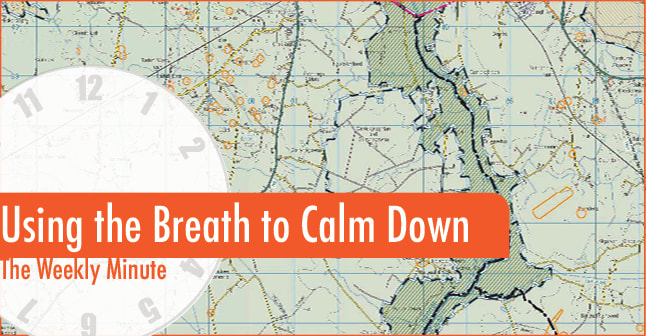|
A simple way to calm down from a stressful event, or during an anxiety attack, is to use something you always have with you–your breath. When we are stressed the Sympathetic Nervous System is activated, this is the body's ancient method of helping keep us safe; if we met a predator in the old hunter-gatherer days, we had 3 options: to fight them, flee from them, or freeze (play dead). We are no longer hunted by wild boar, but the body responds in the same way to any perceived threat, real or imaginary. The same systems are activated whether we are in a fender bender, or a friend blanks us on the street. You can probably tell your Sympathetic Nervous System is activated if your heart rate has sped up, your breath has quickened, and possibly your limbs are tingling or shaking (they're ready to sprint to safety!). In the old days, once the threat disappeared, the Parasympathetic Nervous System would kick in and restore balance. This system reduces the heart rate and blood pressure, returning the body to a relaxed state. Now however, our faster pace of life can have us in a low level of stress, making it more difficult for the Parasympathetic Nervous System to do it's thing. We can add to this by keeping the threat alive in our minds, replaying the scenario over and over in our heads. The body doesn't know the difference between a thought and reality, so it responds in the same way, activating the Sympathetic Nervous System active against the perceived threat. A simple way to calm down is by making the exhale longer than the inhale. Doing this, you consciously activate the Parasympathetic Nervous System, telling the body it's safe to relax, the threat is gone, all is well. If you count the breath as you go, your mind is kept busy and doesn't have time to go over the event, keeping it alive in your thoughts. The next time you find yourself feeling stressed, or after an upsetting event, thy this:
"If prolonged, however, the stress signals whizzing through the body wreak havoc. Besides maintaining a mental feeling of constant stress, the extra epinephrine and cortisol damage blood vessels, increase blood pressure and promote a buildup of fat. So, while the fight-or-flight response serves a purpose, you don't want it switched on all the time." - Live Science
0 Comments
Your comment will be posted after it is approved.
Leave a Reply. |
The Weekly Minute is a blog I write each week with the aim of providing proven tools to help promote positive mental health.
The collection of short, practical mindfulness and therapy tools for self-reflection and self-improvement, can equip people to take their mental well-being into their own hands, and improve their quality of life. The Weekly Minute is posted here every Monday, or you can sign up to get it delivered to your inbox via the link below. Follow me on social media (see below) to make sure you don't miss one! Get the Weekly Minute delivered straight to your inbox, or follow it on social media!
Categories
All
Archives
March 2021
Privacy Policy
By subscribing to Claire Shannon Therapy you are agreeing to receive a weekly blog post via email. I use Mailchimp to store and manage this mailing list and your data will not be shared with any third party. You are free to unsubscribe at any time using the unsubscribe button which appears at the end of every blog. You may wish to review the Mailchimp privacy policy. This privacy policy will regularly be reviewed and any updates will be listed here. This privacy policy was last updated on the 21st May 2018. |
Let's talk soon...
HoursMonday: 10am - 6pm
Tuesday: 11am - 7:30pm Wednesday: Closed Thursday: 11am - 7:30pm Friday: 10am - 6pm Email: [email protected]Tel: 089 208 7678
|
Unit 3 Liosban Industrial Estate, Tuam Road, Galway. H91 H63P
|
With assistance from the Local Enterprise Board, Galway
|



 RSS Feed
RSS Feed
